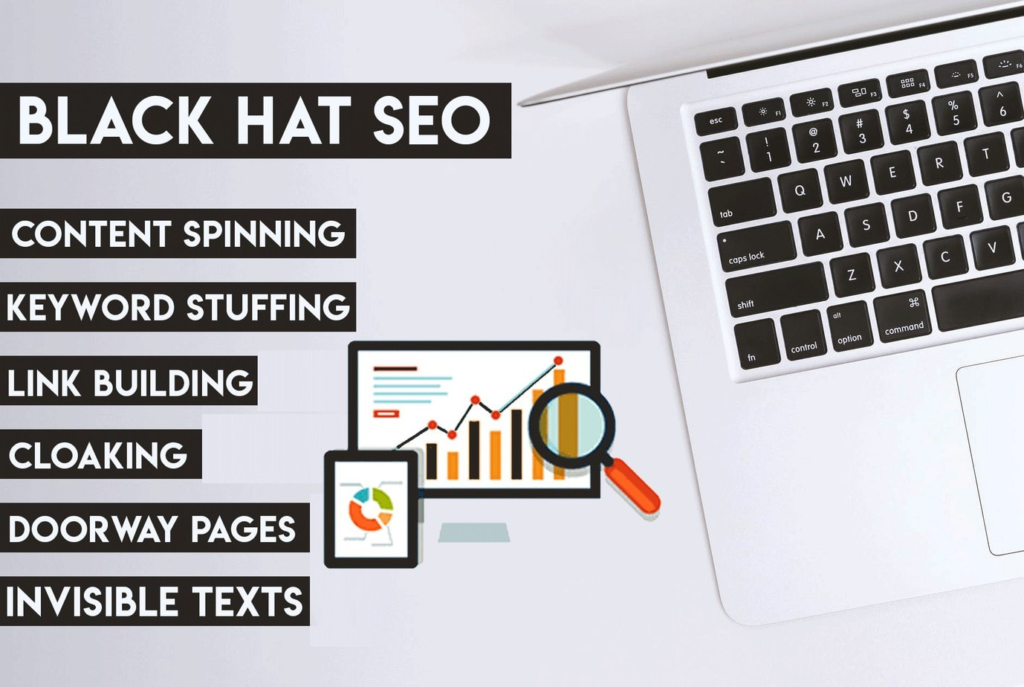The 4 Types of SEO: What They Are and How to Use Them

Search Engine Optimization (SEO) is the process of fine-tuning your web pages to drive more traffic through search engine visibility. Most people may think that the careful choice of keywords and smart use of language are key factors that influence SEO. But, there’s more.
There are various types of search engine optimization digital marketing, and this includes everything from building links, posting on directories, and engaging with social media, among others.
To narrow down the main types of SEO for better rankings, we have categorized 4 types of SEO you should know. This post will tell you the importance of each type of SEO and what comprises an effective SEO strategy.
4 Types of SEO
By implementing the various types of SEO, you can get better results and ensure that the fine-tuned web presence is attracting a lot of interest from searchers. Here are the 4 types of SEO techniques you should know.

1. White-Hat SEO (on-page)
White-Hat SEO is a great method, if optimized correctly, to boost your SEO rank organically, though it may take time.
According to Google, there are a few SEO techniques that you can implement as part of your White Hat SEO to rank higher among the search results for a given keyword.
These insights are aligned to Google’s search algorithm, which is always searching for credible sources, just like every internet user.

Here are some White-Hat SEO techniques to follow.
Good quality content
If you want to get leads, you have to produce high-quality content. Using infographics, e-books, video content, and blogs can help you generate a lot of traffic. But the content you provide should be relevant to the search intent.
HTML optimization
By removing bad links and optimizing your HTML layout, you can ensure that your site performs better. Start using white space effectively, reducing redundant text, and cleaning up the ineffective code.
Social sharing
Building a social media presence is great for improving online visibility. By creating quality content on social media, you can gather a lot of engagement, which turns into web traffic to your pages.
User-friendly design
By keeping people on your site pages for longer, the search engine recognizes the value you provide to users. This type of search engine optimization is called experience design, where your site is made easier to navigate, has interactive elements like videos and photos, and some downloadable resources for users to take away from their experience.
White-Hat SEO is among the main types of SEO because effective implementation guarantees great results in the long term. By nurturing a steady increment in traffic growth, your website ranking improves.
Google often updates its algorithm in light of new trends and the emergence of new types of content. Hence, practicing White-Hat SEO can keep you updated and in a position to tackle any changes caused by the algorithm updates. As the algorithm changes, you may have to adjust your SEO efforts accordingly by learning about more relevant keywords and creating even better content.
In the long run, White-Hat SEO techniques are a proven and effective method to keep updated, improve your site’s rankings and overall performance, and generate more leads over time.
2. Black-Hat SEO

The technique of exploiting search engine algorithms to rank your website higher is called Black-Hat SEO.
The main motive for businesses to employ Black-Hat SEO is to drive results quicker. Without putting in too much work, you can achieve the goals of better traffic and increased engagement. However, the downside is that it’s not the best long-term SEO strategy and can hurt your site performance eventually.
Let us explore the numerous tactics used in these types of SEO efforts.
- Keyword stuffing: Creates a bad impression on the user.
- Link spamming: Any form of spam hurts your credibility.
- Cloaking: Information cloaked for better indexing while information is presented differently to the user.
- Hidden links/text: An attempt to exploit search engine crawlers by inserting hidden elements in the site’s code.
- Plagiarized content: Using high-performing third-party content to rank higher.
- Buying links: A method used to gather search engine visibility through a linking strategy.
- Irrelevant content: Similar to keyword stuffing, where you position content on pages just to improve the SEO value without addressing the search intent.
Google algorithm updates are more focused on quality. If your site is caught spamming or exploiting the algorithm in the ways mentioned above, your site ranking will drop.
Search engines are known to punish websites and ban them based on the irrelevance of their content to users’ search intent. Google is adamant about delivering quality content to people seeking information on their platform.
Black-Hat SEO techniques can be effective if you generate a lot of traffic to generate views on ads or get fast results by ranking higher. However, these tactics aren’t the best way to optimize your site performance.
3. Gray-Hat SEO
In the middle of White-Hat SEO and Black-Hat SEO lies the types of search engine optimzation in digital marketing that fall under a gray area of practice. Gray-Hat SEO isn’t always good for your site, but it doesn’t fall under bad practices.
Gray-Hat SEO techniques are not banned by search engines like Google or Bing, unlike Black Hat SEO. But they are a risky method of generating leads. That said, it’s also an affordable solution; thus, businesses use these types of SEO in digital marketing.
Let’s take a look at some Gray-Hat SEO examples and techniques.
- Spun content: Rephrased blogs and articles that serve the purpose of generating content.
- Exchanging links: Partnering with other similar websites to exchange links through guest posting, blogging, video marketing, affiliates, etc., to improve the domain value.
- Clickbait articles: Using clickbait text and visuals just to get people to click, often without any congruent value at the end of their visit.
- Paid reviews: A way to promote your products or services by flooding other domains with paid reviews, which aren’t always based on real experiences.
Using Gray-Hat SEO techniques, you can improve your site’s ranking on search engines and generate some good traffic. But it’s not the best growth strategy for your online presence. If users do not get any value in the future, your site will be impacted negatively.
4. Negative SEO
Negative SEO is the practice of hurting competitor rankings by positioning content that’s against their brand or products. This is evident among local and global companies looking to impose their product or service as a better fit.
The use of Gray Hat and Black Hat types of SEO in digital marketing to cause harm to a competing website’s or brand’s reputation is called Negative SEO. These techniques are aimed at hurting a competitor’s rankings to position themselves as the better solution.
Here are some Negative SEO techniques used by businesses:
- Negative reviews
- Website hacking
- Negative link building to competitor sites
The main motive of negative SEO is to harm another business and this is damaging for a business on the receiving end because it’s hard to track. To ensure that your business doesn’t fall prey to negative SEO tactics, you should constantly monitor and assess your site’s performance and address all unusual activity.
Businesses and individuals want results, and they want them fast. However, it’s always good to use practical, ethical, and clean SEO to boost your website rankings, rather than negative SEO practices.
On-Page and Off-Page SEO: How to Use Them
SEO is a vast field within a broader field called digital marketing, which is constantly evolving. With the immense knowledge available, you should always use credible information that applies to your goals.
Let’s look at on-page SEO and types of off-page SEO and explore how they can help enhance your page rankings.
On-page SEO
Many types of on-page SEO are the most widely used strategy for growing your business or brand. In simple terms, on-page SEO refers to augmenting your website contents to improve your site’s overall performance.
Keyword optimization is the most common type of on-page SEO. This process involves choosing a list of niche-specific keywords that target users’ search behavior.

So, when a searcher types in the relevant keywords, Google can display a set of associated results. Keyword optimization helps your website rank higher thus.
For businesses to generate quality leads, keyword research is an important type of on-page SEO. The process of identifying and employing suitable keywords helps searchers find you.
By positioning these keywords and phrases in clever areas of your web page layout, metadata, captions, headings, etc., you make yourself more visible to searchers.
On-page SEO boosts visibility. Using target keywords and phrases closely associated with your niche of products and services, you can create quality content that ranks higher on the search engine. This results in more leads and increased revenue for your business.
Among the types of on-page SEO techniques, URL optimization is very useful. A customized URL can help visitors to your site recognize and remember your brand better. This improves the brand recall value for your pages.
For example, take these URLs
www.peppercontent.com/find-competitor-keywords/
vs
www.peppercontent.com/blog/find-competitor-keywords/page-2135466/pageID-99873
Which one seems like a URL you will remember?
The first URL is more concise; people know what the page contains before visiting. That’s the magic of URL optimization. Part of SEO is letting users and the search engine know what to expect when they visit your site pages.
You can use these two main types of on-page SEO to improve your site’s performance and navigation.
Other types of on-page SEO include meta description optimization, internal linking strategy, and image compression. It is important to know that on-page SEO is all about fine-tuning elements on your website and its pages to stand tall as a credible source of information.
Off-page SEO
Off-page SEO refers to optimizing areas that aren’t on your website. These external attributes influence the way your site performs. Thus, off-page SEO is a vital aspect of SEO.

Let’s explore some main types of off-page SEO.
As mentioned above, social sharing can be a huge traffic booster. You may not always know how the audience will react when you share your blog or other links on social media. This external factor influences your site’s ranking, though.
So, how do you ensure your site’s performance improves with social sharing?
First, understand that social listening is not the only aspect of SEO performance. They don’t directly impact your site’s ranking but can improve your site’s visibility and result in better rankings on search engines as well.
When sharing content on social media like YouTube, LinkedIn, Facebook, Twitter, or other platforms, you have immense potential to improve your linking strategy for your website. People who share your links and engage with your content help drive traffic to your site’s pages. This form of traffic is specific to those seeking the exact information you have. Thus, your site rankings improve over time.
Other off-page SEO factors are backlinking, directory listings, and online reviews. From credible third-party sources, if you can drive traffic to your website, the search engine recognizes this behavior as a positive influence on your content.
So, you have to optimize the elements you share on various platforms outside your website by following the best practices to make your content more relatable, relevant, and engaging to its users. These external factors can eventually result in better rankings for your brand or business online.
Final Words
Companies can drive more value in producing content and generate ideal visitors using these 4 types of SEO techniques. Thereby, site rankings go up, and domain value increases.
That’s how to position your web pages as the favorite source for the search engine algorithm.
Using White Hat techniques is best to complement the algorithm and retain your site’s authority as a credible source of information. But that doesn’t mean you can’t dabble in the gray areas as long as you don’t hurt your reputation and maintain ethical practices.

FAQs
White hat SEO, black hat SEO, gray hat SEO, and negative SEO are the main types of SEO. White hat is the most sustainable long-term plan for most businesses.
Keyword research and optimization include finding relevant keywords you can use for your pages and content and shortlisting the right ones to match the search intently you aim to address. URL optimization is the process of refining your URL structures, so people can relate and remember the page better. Both are effective on-page SEO practices.
Social sharing paired with an effective backlinking strategy is effective off-page SEO. Using relevant content and linking to credible sources on the internet helps improve your page’s domain value.
Yes, credible and relevant blogs are a great way to generate quality content that improves your site’s visibility on search engines and nurtures your target audience with information. Blogs are also a great way to continuously show activity on your website, which results in better rankings. Opt for Pepper Content’s blog writing services for boost your SEO game.
Latest Blogs
Explore how Google’s 2025 AI search updates triggered ranking chaos. Learn actionable strategies to adapt your SEO for AI Overviews, zero-click searches, and SERP volatility. Stay ahead now.
Learn how to rank on AI search engines like ChatGPT, Perplexity, and Gemini by optimizing your content for authority, structure, and relevance. Stay ahead in AI-driven search with this strategic guide.
Explore the best healthcare SEO services for your medical practice. Improve online visibility and effectively reach more patients in need of your services.
Get your hands on the latest news!
Similar Posts

Artificial Intelligence
6 mins read
The Role of AI in Digital Marketing: AI Article Generators Transforming Content Creation

Artificial Intelligence
4 mins read
How AI Content Creator Is Shaping the Future of Digital Content

Digital Marketing
3 mins read